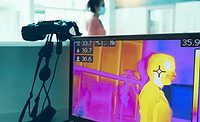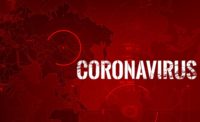Biometrics will enable many COVID-19 changes

Expect the COVID-19 coronavirus pandemic to bring lasting changes to our lives, from the way we authenticate identity to how we open doors – and even use public restrooms. If there’s a theme among these changes, it’s that they will favor contactless solutions.
The use of biometrics to authenticate employees and customers has snowballed over the last decade. Expect demand from public and private organizations to grow even faster as they require accurate identification of workers, students, patients and many more people in response to new challenges resulting from the virus.
The potential spread of COVID-19 has people wary of touching keypads, card readers and other devices used for accurate identity authentication. The Centers for Disease Control and Prevention said people might become infected by touching a surface containing the virus, which may survive for hours outside a host.
Technologies, such as iris and facial recognition, offer accurate solutions to identify people in person and online. And, importantly, these contactless systems do not contribute to the spread of the coronavirus and other pathogens.
Here are some examples of recent initiatives where biometrics are playing a role.
Correctional facilities house prisoners in very compact areas, creating an almost ideal environment for spreading disease. Prison and jail administrators are releasing many non-violent offenders to reduce their chances of becoming infected. Biometrics can eliminate mistaken identities during the release process as well as provide law enforcement with a tool to identify freed prisoners as part of their bail terms.
Social benefits, such as unemployment and nutritional programs, help millions of Americans impacted by layoffs and business failures. The use of biometrics can reduce fraud and ensure the benefits are going to the appropriate person. A good example comes from India with its iris-based national ID project that tops 1 billion enrolled residents. The program daily receives more than 4 million authentication requests.
Medical experts say people who’ve recovered from COVID-19 may safely re-enter the workplace. Some local health agencies issue employees card-based health certificates as proof of them having had the virus. The cards would include chips containing a template of the owner’s biometric. Employers can eliminate fraudulent use of the certificate by comparing a live biometric to the one stored in the card. A contactless biometric makes tremendous sense to avoid potential contamination.
Distance learning will continue this fall as millions of college students log into networks for virtual instruction. Professors and administrators need to verify attendance and the identity of those taking tests. Biometric readers linked to a student’s computer provide that required verification.
During telemedicine sessions, healthcare practitioners use contactless biometrics to be confident patients are receiving proper treatments. Also, this practice helps ensure the protection of patients’ privacy.
While many employees have returned to the office, millions are still working from home using their own or company-provided computers and devices. Either way, employers need biometrics to know that only authorized workers are logging onto the corporate network. Law enforcement officials warn that experienced hackers know how to defeat tokens and multi-digit codes. That’s why the FBI last year recommended organizations add biometrics to their identification process.
Organizations are looking for ways to open doors without touching the hardware. Solutions may include sensors or foot pedals capable of electronically opening entries without the need to pull handles or twist knobs and levers. Touchless switches mounted at entry points could sense the wave of a hand. Motion detectors may also open doors. The use of contactless biometrics adds a layer of security and safety.
Biometrics are ideal for use with elevators. Readers will authenticate employees and call a car to take them to their floor without having to touch any buttons. Buildings may employ voice controls for visitors.
Even public restrooms will see changes, some of which are already in place. Sensors capable of detecting people will replace levers, buttons and knobs on toilets, sinks and soap dispensers. Locating hand-washing stations outside restrooms will relieve overcrowding. High-velocity, wall mounted hand dryers, capable of blowing germs across the room, will give way to dryers integrated into sinks.
Privacy is another issue when it comes to using digital identity technologies. Some options, such as iris recognition, are opt-in solutions – a person is aware of the system and agrees to enroll in the database. The use of biometrics ensures someone isn’t fraudulently using another person’s identity.
Market research companies are predicting significant growth of biometric solutions, particularly non-contact modalities. Also, look for combinations of biometric technologies employed as additional layers of ID authentication and security.
We may soon return to attending sporting events and concerts and traveling safely across the country and around the world. But many of the changes resulting from the coronavirus will last far into the future. The security industry will provide many of the solutions to meet these new challenges.
Looking for a reprint of this article?
From high-res PDFs to custom plaques, order your copy today!






